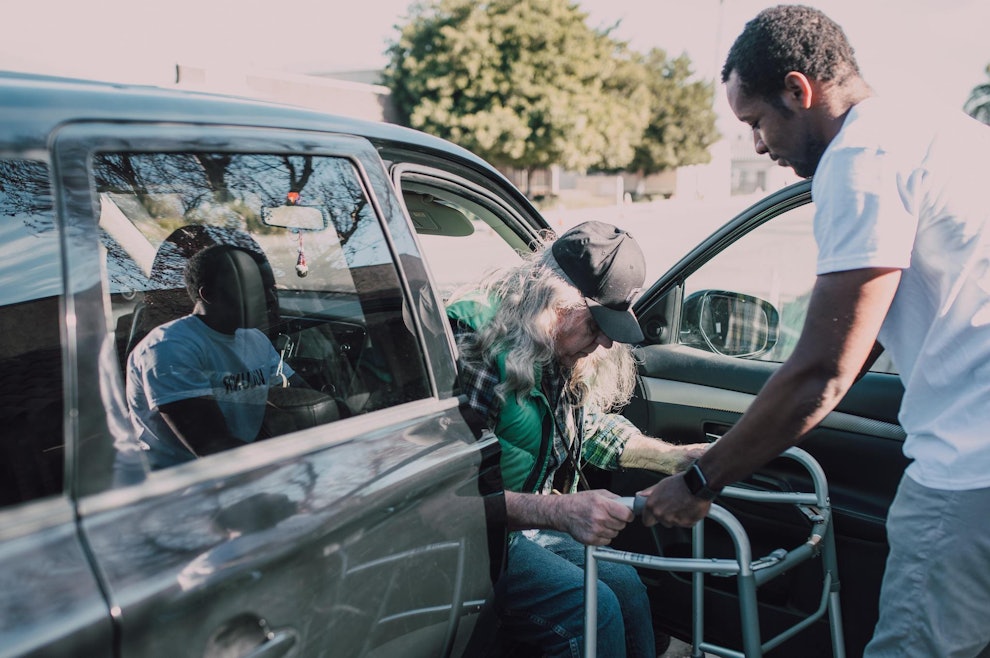How To Use A Walker: Tips And Advice
Article at a glance
Using a walker can be tricky at first but will get easier in time.
There are a few types of walkers to choose from including a standard walker without wheels, walkers with wheels, and a knee walker.
How you use your walker will vary based on what type of movement you are doing (i.e. getting up and down from a chair, climbing stairs, etc.).

Learning to use a walker correctly can take a fair amount of practice to get right. This article will provide the basics of using a walker including the different types, how to walk, how to sit down, how to climb stairs, safety tips, and more.
Signs You Might Need A Walker
Some potential signs you could benefit from using a walker include:
You cannot rely on one, or both, of your legs while standing
You get fatigued easily when walking
You have poor balance
You want to stay independent despite physical limitations
You have fallen in the past
A cane is not effective support for your needs
Types Of Walkers
There are a variety of types of walkers you can choose from:
Standard Walker (Pickup Walker): A standard walker has four legs with rubber tips and no wheels, which means it requires a lifting motion in order to be used. This type of walker provides the most stability.
Two-Wheel Walker: A two-wheeled walker has two wheels on the front two legs of the apparatus. Two-wheeled walkers are beneficial for those who need help bearing weight or who are unable to easily lift a standard walker.
Three-Wheel Walker: A three-wheel walker has three wheels out of the four legs. It provides greater mobility than a four-wheel walker and is lighter in weight.
Four-Wheel Walker: A four-wheel walker has wheels on each leg. It is less stable than a standard walker but is helpful for those who struggle with being steady on foot. Four-wheel walkers often have a seat option.
Knee Walker: A knee walker has four wheels, a platform for the injured leg to rest on, and a handle. A knee walker is used by having the other leg push the walker forward. These types of walkers are often only required for a short period of time, during recovery from an injury or procedure.
Your healthcare provider or physical therapist will help you select the best walker for your particular situation.

How To Use A Walker: The Basics
There will be various scenarios in which using a walker will differ (i.e. walking, going from standing to sitting, etc.). However, in all cases, there are a few basics to keep in mind while using a walker:
For walkers with wheels, you will need to push the walker’s legs forward in order to move forward.
For walkers without wheels, you will need to lift the walker upward and then place it in order to move forward.
All four wheels or legs of the walker must be sturdy on the ground before you bear weight on it.
Always keep your head up and forward while walking, do not look downward.
Ensure your walker is adjusted for your height. The handles of a walker should be level at your hips and your elbows should be slightly bent while holding the handles.
Follow your doctor’s weight-bearing instructions in order to get the best and safest use of your walker.

How To Walk Using A Walker
For walking with a walker:
Depending on the type of walker, push or lift the walker the appropriate length away from you (do not hunch your back over the walker).
Before taking your first step, ensure that every single leg of the walker is on the ground.
Step forward with your weak or injured leg first.
Next, step forward with your other leg next, placing it in front of the other. While doing this, ensure you push straight down on the handles of the walker to support your body weight.

How To Go From Sitting To Standing
To go from sitting to standing using a walker:
With the open side of the walker facing you, place the walker in front of you.
Before moving, ensure that every single leg of the walker is on the ground.
Leaning forward a bit, use your arms and the chair arms to help you stand up. Do not use the walker to support you as you stand up. Ask for help getting up if necessary.
Once upright, grab the handles of the walker.
Before moving, make sure all the legs of the walker are still on the ground.

How To Go From Standing To Sitting
To go from standing to sitting while using a walker:
Back up to the chair until your legs touch the chair.
Before moving, ensure that every single leg of the walker is on the ground.
Reach back with one hand and take hold of the armrest. (Note: If both of your legs are impacted, reach back with one hand first then use the other.)
Leaning forward, move your weaker leg ahead.
Slowly lower yourself into the chair and slide into your desired position.
How To Climb Stairs
To climb up the stairs while using a walker:
Put the walker on the stair in front of you.
Before moving, ensure that every single leg of the walker is on the ground.
Step up with your strong leg first. Then, with your full weight bearing on the walker, lift your other leg to the stair.
To climb down the stairs while using a walker:
Put the walker on the stair below you.
Before moving, ensure that every single leg of the walker is on the ground.
First, step down with your weak leg. After that, place all of your weight on the walker and lower your strong leg down next to your other leg.

How To Use A Walker With An Injury
Sometimes, walkers are a temporary solution to help the healing process following a procedure or injury. In cases such as these, there may be other strategies that need to be used to keep strain off the affected leg.
Below are some examples of ways to use a walker with varying levels of weight bearing.
Non-Weight Bearing Method
No weight will be put on the affected leg. While using the walker, keep the impacted leg off the ground. As always, ensure that the legs of the walker are firm on the floor.
Next, move the walker in front of you. Pushing down on the walker using your arms, hop the good leg into the middle area of the walker.
Partial-Weight Bearing Method
A partial-weight bearing means that 30 to 50 percent of your body weight has been approved to be used on the impacted leg. Place your walker in front of you. As always, ensure that the legs of the walker are firm on the floor.
Next, step your injured foot into the walker. Using your arms to keep some of your weight off your injured leg, take your good leg and step it into the middle of the walker.

Safety Tips For Using A Walker
Using a walker safely is important. Some tips include:
When walking, start with your weaker leg. (If you need a walker due to surgery, the weaker leg would be the leg you had surgery performed on.)
When stepping up on a stair or curb, use your good leg first. However, when going down a stair or curb, use the weak or injured leg first instead of the stronger leg.
Always keep space between yourself and the walker, keeping your toes inside the walker in order to stay balanced.
Make changes around your house to prevent falls such as getting rid of loose rugs, cords, clutter, etc. Always ensure your floors are clean and dry as well.
Wear appropriate footwear, shoes or slippers with rubber or non-slip soles. Avoid shoes with heels or leather soles.
Keep your walker in tip-top shape by making sure rubber tips and other equipment are not worn down. If parts of your walker do show signs of wear and tear, replace them.
Skip the stairs or escalator until you’ve been trained by your physical therapist or healthcare provider.
Caregiver Tips: How to Help Someone Walk With A Walker
For caregivers or anyone helping a loved one with a walker, some tips include:
Help them practice. And be patient while you help them learn. It can be frustrating to learn to use a walker.
Be encouraging. Especially if the person using the walker is reluctant to use it. Remind them that it’s there to help them and will make their life better.
Assist them when they change from sitting to standing positions. Particularly at first, when they’re first learning walker safety and how to use it properly. Remind them to not use the walker to pull themselves up. Instead, they should slide forward on the seat, feet planted steadily on the ground. To rise, they can use the arms of the chair to support them if needed. Ensure that the walker is directly in front of them when they plan to stand up.
FAQ
How do you carry items with a walker?
Many walkers can be equipped with accessories to make carrying things easier. For example, some walkers are able to have trays, baskets, and drink holders affixed to them. You can visit a medical supplies store to see accessory options.
How do you help an elderly person with a walker?
To support an elderly person using a walker, simply stand beside them or behind them and support their weight by placing a hand on their lower back. Be sure to never push or pull the walker forward for them.
Do you lift a walker when walking?
If a walker has wheels, it will simply need to be pushed forward in order to be moved. However, if a walker does not have wheels, the walker will need to be lifted up and placed in front of you while walking. Be sure when you place the walker back down that all four legs are touching the ground.
Sources
https://my.clevelandclinic.org/health/articles/15542-how-to-use-a-walker
https://www.mayoclinic.org/healthy-lifestyle/healthy-aging/in-depth/walker/art-20546805
https://halohealthcare.com/en-us/blogs/news/7‑signs-that-show-you-should-be-using-a-walker
https://advantagehomehealth.ca/3‑best-practices-for-helping-a-loved-one-who-uses-a-walker/
Become a patient
Experience the Oak Street Health difference, and see what it’s like to be treated by a care team who are experts at caring for older adults.




